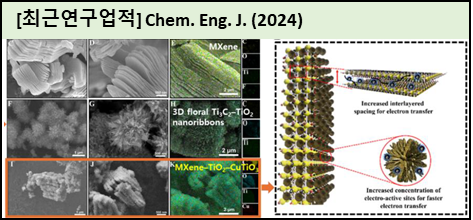|
Title |
Ti3C2Tx-MXene based 2D/3D Ti3C2–TiO2–CuTiO3 heterostructure for enhanced pseudocapacitive performance |
|
Author list |
Muhammad Noman, Mirza Mahmood Baig, Qazi Muhammad Saqib, Swapnil R. Patil, Chandrashekhar S. Patil, Jungmin Kim, Youngbin Ko, Eunho Lee, Jinwoo Hwang, Seung Goo Lee*, and Jinho Bae* |
|
Publication date |
2024.11.01 |
|
Citation information |
Chemical Engineering Journal, 499, 156697 (2024) |
|
Abbreviation of Journal Name |
Chem. Eng. J. |
|
DOI |
https://doi.org/10.1016/j.cej.2024.156697 |
|
Graphical Abstract
(Do not change the size of box, and also do not remove the citation information.) |

|
|
Abstract
(superscript and subscript cannot be allowed.) |
Ti3C2Tx MXene family is a promising electrode material for electrochemical energy storage, but it suffers from insufficient pseudocapacitive charge storage because of self-aggregation and oxidation degradation. To resolve the issue, this paper proposes a two-step process for synthesizing oxidation-controlled MXene-derived 2D/3D heterostructures that beneficially utilize oxidation and simultaneously improve conductivity. The first step generates in-situ 3D floral Ti3C2– TiO2 nanoribbons under partial oxidation of MXene. As the second step, further controlled oxidation with Cu ions transforms the 3D floral Ti3C2–TiO2 nanoribbons into 2D/3D Ti3C2–TiO2–CuTiO3 heterostructure. Leveraging the synergistic effects of MXene, TiO2, and CuTiO3, this 2D/3D heterostructure enhances the interlayered spacing, redox-active site concentration and alleviates low conductivity issue associated with TiO2 nanoribbons. At 2 mA/cm2, the proposed 2D/3D Ti3C2–TiO2–CuTiO3 heterostructure achieved a significantly higher capacitance of 599.2 mF/cm2, compared to MXene with a capacitance of 249.16 mF/cm2 and 3D floral Ti3C2–TiO2 nanoribbons with 498.5 mF/cm2. For practical evaluation, an asymmetric supercapacitor (ASC) device (Ti3C2–TiO2–CuTiO3//AC) was fabricated, which exhibited an energy density of 31.1 Wh/kg, power density of 1041.7 W/kg and capacitance retention of 83.7 % after 5000 continuous charging/discharging cycles. It opens new avenues for utilizing controlled oxidation to enhance pseudocapacitive properties. |
|